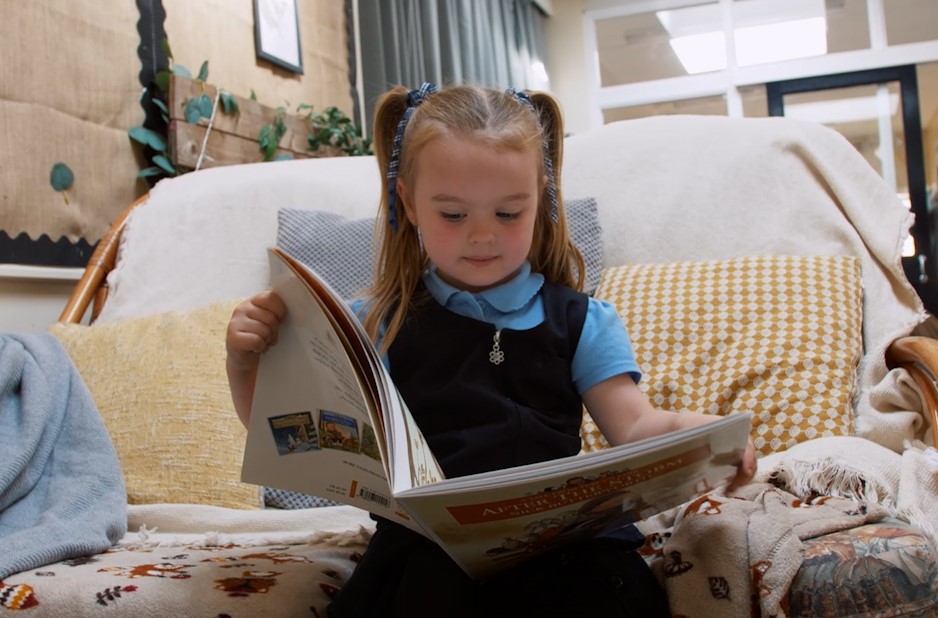Phonics

“Staff expertly support pupils to ensure that all pupils have a secure phonics base.”
“…the vast majority of pupils are reading with high levels of confidence and fluency by the time they get into key stage 2.”
Ofsted Report May 2022
As a school, we use Jolly Phonics to teach a high-quality programme of systematic synthetic phonics.
Click below to read about our approach to Phonics and Reading, find out more about sound buttons or listen to the pronunciation of each of the phonemes taught during our phonics lessons:
At Woods Loke, we consider reading to be at the heart of everything combining two key areas:
-
developing an ability to read with fluency and understanding
-
growing a love of reading through immersion in a wide range of stories and texts
Parent Workshops
We hold a regular series of phonic workshops in our Community Hub. As well as this, information sessions are held for parents and carers about the national phonics screening check, which all year 1 children will take part in during the Summer term. These sessions are also open to parents of year 2 children who are being re-screened. Further information will be sent home nearer the time.
Further resources can also be found at www.tcrw.co.uk which offers free resources and advice from the creator of our school phonics programme.
How phonics is taught at Woods Loke
Phonics is a way of teaching children how to read and write by developing their phonemic awareness—the ability to hear, identify, and manipulate different sounds used in the English language. Children learn the correspondence between these sounds and the spelling patterns (graphemes) that represent them. At Woods Loke Primary School we place a strong emphasis on the teaching of phonics in the early years of reading and writing, in order to give all children a solid foundation for learning.
The teaching of phonics takes place through structured and clearly sequenced daily teaching of Systematic Synthetic Phonics (SSP) lessons and activities. This begins in Nursery and Reception, using the validated phonics scheme Jolly Phonics. Sounds are introduced at the rate of 3-5 per week throughout the Autumn and Spring, with children consolidating these in the Summer term. In Years 1 and 2, the children learn alternative spellings of the previously learned sounds, refining their knowledge to become more fluid readers and accurate spellers.
Phonics sessions are organised around the revision of previously learned letter-sound correspondence, learning of new ones, practicing these and then applying them in sentence level work. Because not all words in the English language comply with the rules of phonics, we also teach so-called ‘tricky words’ by repetition and retrieval.
Our Jolly Phonics scheme incorporates phonetically decodable texts that children can access once they are taught the related phonemes. This feeds into our school book bands, which are matched closely to these and run parallel to them.
We use regular formative assessments to identify any children who have a possible gap in their phonics knowledge, addressing these immediately to ensure that all pupils make the best possible progress. For those children who are not yet able to pass the phonics check or who fall behind receive focussed support to help them succeed. We also run catch-up programmes to help those pupils who require phonics support beyond Year 2.
Year 1 Phonics Screening Check
All children in year 1 take part in the statutory national Phonics Screening check during the Summer term. The check is a booklet containing 40 words, which the child reads one to one with their class teacher. These words are a mixture of real words and nonsense words, which the children often refer to as 'alien words'. The screening has been designed to check that each child has developed the expect level of phonic knowledge for their year group. The children do not need to be able to identify which words are real and which are not, though the presence of an alien image beside the nonsense words means that most children can!
The screening checks that each child can:
-
Sound out and blend graphemes in order to read simple words e.g. n-igh-t.
-
Read phonically decodable one-syllable and two-syllable words, e.g. cat, sand, windmill.
Please ensure that your child is in school during this week.
Home learning
There are lots of resources and activities available online which can be accessed from home.
We use Phonics Play during our phonics lessons and the children are familiar with many of the games and activities. Unfortunately our in-school subscription does not extend to home use, but some games are free to play. A yearly subscription costs £12.
www.ictgames.com/literacy.html
ICT Games is a site we often use in school as it has a wide variety of free English and Maths games. Some of these games are tablet friendly too.
Twinkl has a wide variety of printable resources which cover all areas of the curriculum, some of which can be accessed for free. To access this website you will need to create an account.

